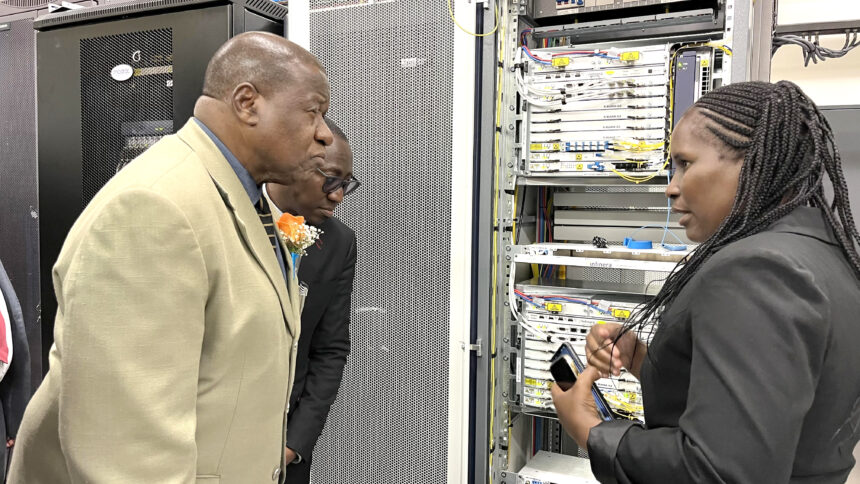Telecom reached a historic milestone yesterday when it activated the Equiano subsea cable in Swakopmund. The Equiano cable system is the third private international cable owned by Google, and the 14th subsea cable invested in by Google.
The cable links Namibia to Europe via Portugal, and to the rest of Africa via Cape Town and Johannesburg. This momentous event signified a quantum leap forward in Namibia’s digital transformation journey, paving the way for an era of unprecedented connectivity and boundless opportunities. This not only paves the way for internet technologies, but also creates possibilities for employment.
The Equiano subsea internet cable is expected to increase internet speed by over 2.5 times its current speed.
The landing was made possible by Telecom Namibia and Paratus Group, who invested N$300 million along with Google.
This dual achievement, according to Deputy Prime Minister John Mutorwa, signifies a transformative leap forward in Namibia’s technological journey, effectively supporting the initiative for bridging the digital divide, and connecting Namibia to a brighter future within the global digital landscape.
Speaking at the activation, which coincided with Telecom Namibia’s 32nd anniversary, Mutorwa said government has long recognised the transformative power of information technologies as a cornerstone for sustainable growth and development.
“This unwavering belief aligns perfectly with the aspirations outlined in Vision 2030, and the National Development Plan 5 and beyond. It envisions a Namibia transformed into a knowledge-based society, leveraging technology for the betterment of all its citizens, as per the Sustainable Development Goals,” he said yesterday.
The arrival of the Equiano cable, alongside the existing West Africa Cable System, serves as a powerful testament to Namibia’s commitment to regional connectivity. He added that these strategic investments, some co-funded with valued partners like the Government of Botswana and Bofinet in the case of WACS, not only strengthen bilateral relations, but also ensure reliable international bandwidth for Namibia and her neighbours.
“This enhanced and diverse connectivity fulfils our obligations under established regional agreements and Memoranda of Understanding within SADC. By facilitating seamless communication across borders, we contribute directly to the overall progress and prosperity of the entire region,” he said.
Mutorwa added that the Equiano cable strategically positions Namibia at the forefront of the Fourth Industrial Revolution (4IR), which is defined by data-driven solutions, and a relentless pursuit of innovation. By providing robust and affordable internet access, Namibia empowers its citizens to become active participants and contributors within this evolving landscape.
”This cable will ensure reliable connectivity to 5G and the Internet of Things. Therefore, bridging the digital divide remains a top priority for the Namibian government. We are actively engaged in upskilling our communities, preparing them to navigate the opportunities presented by 5G, among others”.
This enhanced connectivity will revolutionise how we conduct business, improve the quality of life for our citizens, and unlock a new wave of economic opportunities across diverse sectors, including agriculture, healthcare, education and logistics. The landing of this cable on Namibian shores and connecting the rest of Africa is Namibia’s contribution towards this noble goal.”
“As such, the Equiano cable’s positive impact extends beyond Namibia’s borders. It serves as a catalyst for regional integration within SADC.
Telecom Namibia’s foresight in positioning Namibia as a regional ICT hub for landlocked nations like Botswana, Zambia, Malawi and the DRC deserves special recognition.
This strategic move not only strengthens our own projected capacity demands, but also empowers these nations to fully participate in the digital age.”
Enhanced connectivity fosters cross-border collaboration, promoting economic development and knowledge-sharing throughout Southern Africa. Furthermore, governments and businesses across SADC can leverage the increased bandwidth to deliver improved services to their citizens and customers.
Also speaking at the activation, Public Enterprises Deputy Minister Maureen Hinda-Mbuende said this development is Namibia’s commitment to regional integration and cooperation to enhance digital connectivity.
This achievement also signified that public enterprises can drive economic growth.
“Our governments continue to work closely to ensure optimal resource utilisation of the ICT sector for the benefit of our citizens. Telecom’s achievement stands as a prime example of how state-owned enterprises can also be successful and contribute to development,” she said.


